Abstract
Study Design
Retrospective, multicenter review of the spinopelvic parameters in young children with scoliosis.
Objectives
To describe sagittal alignment of the spine and pelvis in young children with scoliosis.
Summary of Background Data
The natural history of spinopelvic parameters has been defined for the first 10 years of life in normal children; however, they have not been described for children with scoliosis. Such information is important because these values can be used as a baseline for the assessment of radiographic outcomes after surgical intervention.
Methods
Seven measures of sagittal alignment were taken from standing lateral radiographs of 80 children with scoliosis (coronal Cobb angle greater than 50°) and compared with age-matched normal children described in the literature. Statistical analysis was performed using 2-tailed Student t tests (level of significance =.05) and Pearson correlation coefficient.
Results
Patients had a mean age of 4.8 years (range, 1 — 10 years) and a mean Cobb angle of 72.0° ± 16°. Mean sagittal spine parameters were sagittal balance (2.2 ± 4 cm), thoracic kyphosis (38.0° ± 20.8°), and lumbar lordosis (49.0° ± 16.6°). These values were similar to those of children without scoliosis. Mean sagittal pelvic parameters were: pelvic incidence (46.5° ± 15.8°), pelvic tilt (10.7° ± 13.6°), sacral slope (35.5° ± 12.1°), and pelvic radius (55.7° ± 21.3°). Pelvic incidence was not significantly different from that of age-matched
Similar content being viewed by others
References
Jackson RP, Hales C. Congruent spinopelvic alignment on standing lateral radiographs of adult volunteers. Spine (Phila Pa 1976) 2000;25:2808–15.
Legaye J, Hecquet J, Marty C, et al. Sagittal equilibration of the spine: relationship between pelvis and sagittal spinal curves in the standing position [in French]. Rachis 1993;5:215–26.
Legaye J, Duval-Beaupere G, Hecquet J, et al. Pelvic incidence: a fundamental pelvic parameter for three-dimensional regulation of spinal sagittal curves. Eur Spine J 1998;7:99–103.
Marty C, Boisaubert B, Descamps H, et al. The sagittal anatomy of the sacrum among young adults, infants, and spondylolisthesis patients. Eur Spine J 2002;11:119–25.
Rajnics P, Pomero V, Templier A, et al. Computer-assisted assessment of spinal sagittal plane radiographs. J Spinal Disord 2001;14:135–42.
Lafage V, Schwab F, Patel A, et al. Pelvic tilt and truncal inclination: two key radiographic parameters in the setting of adults with spinal deformity. Spine (Phila Pa 1976) 2009;34:E599–606.
Mac-Thiong JM, Berthonnaud IE, Dimar JR, et al. Sagittal alignment of the spine and pelvis during growth. Spine (Phila Pa 1976) 2004;29:1642–7.
Vaz G, Roussouly P, Berthonnaud E, Dimnet J. Sagittal morphology and equilibrium of pelvis and spine. Eur Spine J 2002;11:80–7.
Labelle H, Roussouly P, Berthonnaud E, et al. Spondylolisthesis, pelvic incidence, and spinopelvic balance: a correlational study. Spine (Phila Pa 1976) 2004;18:2049–54.
Cil A, Yazici M, Uzumcugil A, et al. The evolution of sagittal segmental alignment of the spine during childhood. Spine (Phila Pa 1976) 2005;30:93–100.
Author information
Authors and Affiliations
Corresponding author
Additional information
Author disclosures: RE (support for travel to meetings for the study or other purposes from the Chest Wall and Spine Deformity Study Group; consultancy for DePuy Spine; grants from Synthes Spine, DePuy Spine, Medtronic Canada, Atlantic Innovation Fund/Atlantic Canada Opportunities Agency, Canadian Institute of Health Research, Pediatric Orthopaedic Society of North America, Tecterra); PFS (consultancy for DePuy Spine; grants from DePuy Spine; stock/stock options from Pioneer Surgical); PJC (consultancy for DePuy Synthes Spine; payment for manuscript preparation from DePuy Synthes Spine; editorial board member for Orthopedics [unpaid]); AFS (consultancy for DePuy Synthes Spine, Zimmer Spine, SpineGuard, Stryker; payment for manuscript preparation for DePuy Synthes Spine); MGV (board membership with Chest Wall and Spine Deformity Study Group, AAP Section on Orthopedics, POSNA; consultancy for Stryker, Biomet, Chest Wall and Spine Deformity Study Group; grants from Scoliosis Research Society; grants from Chest Wall and Spine Deformity Research Foundation, POSNA, OREF, OMeGA, AOSpine, Medtronic; royalties from Biomet; travel/accommodations/meeting expenses from Chest Wall and Spine Deformity Study Group, Fox PSDSG, Broadwater [funded by Biomet, Synthes, Stryker, Medtronic, K2]); PGG (consultancy for DePuy Spine; payment for lectures including service on speakers bureaus from DePuy Spine); NDB (grants from Synthes to author’s institution); CRD (support for travel to meetings for the study or other purposes from Chest Wall and Spine Deformity Study Group); CH (none); JJH (grants from Atlantic Innovation Fund and Tecterra); SHM (grants from Globus Medical Quality, Safety, Value Spinal Deformity Research Grant); JTS (board membership with Chest Wall and Spine Deformity Study Group; consultancy for DePuy-Synthes Spine; royalties from VEPTR 2 Device).
Rights and permissions
About this article
Cite this article
El-Hawary, R., Sturm, P.F., Cahill, P.J. et al. Sagittal Spinopelvic Parameters of Young Children With Scoliosis. Spine Deform 1, 343–347 (2013). https://doi.org/10.1016/j.jspd.2013.07.001
Received:
Revised:
Accepted:
Published:
Issue Date:
DOI: https://doi.org/10.1016/j.jspd.2013.07.001



